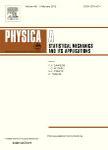版权所有:内蒙古大学图书馆 技术提供:维普资讯• 智图
内蒙古自治区呼和浩特市赛罕区大学西街235号 邮编: 010021

作者机构:Xidian Univ Sch Comp Sci & Technol 2 South Taibai Rd Xian Shaanxi Peoples R China Xidian Univ Sch Econ & Management 2 South Taibai Rd Xian Shaanxi Peoples R China
出 版 物:《PHYSICA A-STATISTICAL MECHANICS AND ITS APPLICATIONS》 (物理学A辑:统计力学及其应用)
年 卷 期:2018年第496卷
页 面:121-136页
核心收录:
基 金:NSFC [61772394, 61502363, 71401130] Natural Science Basic Research Plan in Shaanxi Province of China [2017JM6030]
主 题:Temporal link prediction Dynamic networks Graph regularization Nonnegative matrix factorization
摘 要:Many networks derived from society and nature are temporal and incomplete. The temporal link prediction problem in networks is to predict links at time T + 1 based on a given temporal network from time 1 to T, which is essential to important applications. The current algorithms either predict the temporal links by collapsing the dynamic networks or collapsing features derived from each network, which are criticized for ignoring the connection among slices. to overcome the issue, we propose a novel graph regularized nonnegative matrix factorization algorithm (GrNMF) for the temporal link prediction problem without collapsing the dynamic networks. To obtain the feature for each network from 1 to t, GrNMF factorizes the matrix associated with networks by setting the rest networks as regularization, which provides a better way to characterize the topological information of temporal links. Then, the GrNMF algorithm collapses the feature matrices to predict temporal links. Compared with state-of-the-art methods, the proposed algorithm exhibits significantly improved accuracy by avoiding the collapse of temporal networks. Experimental results of a number of artificial and real temporal networks illustrate that the proposed method is not only more accurate but also more robust than state-of-the-art approaches. (C) 2017 Elsevier B.V. All rights reserved.